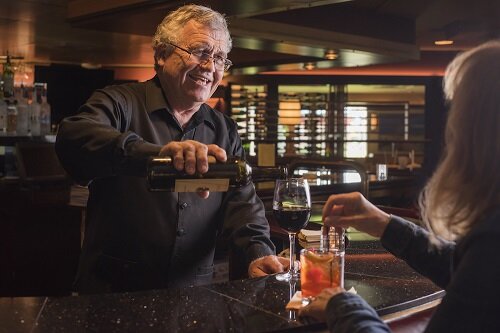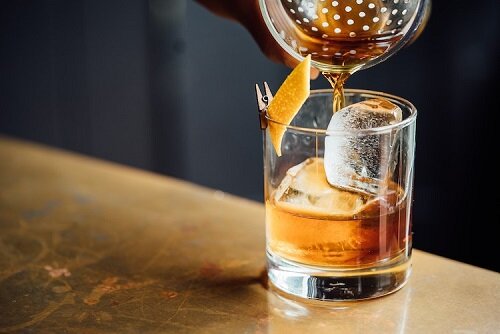Uncovering the True Origin of the Wisconsin Brandy Obsession
At The Del Bar
When I began researching my Wisconsin Cocktails book, the brandy question loomed large. Wisconsin drinks more brandy than any other state, and most of our brandy consumption goes into the Wisconsin old fashioned – a muddle of sugar, bitters, orange and maraschino cherries topped with brandy and then sweet or sour soda and a bevy of garnishes. Thus, I knew going into this book, that the most important research would center on brandy.
So, I set out to prove the most popular story about the origins of our brandy obsession.
The Korbel Brothers and the Columbian Exposition
World Columbian Expo. photo credits to "World's Columbian Exposition - Portfolio of views 1893"by crackdog is licensed under CC BY 2.0
The story goes something like this: the three Korbel brothers – Francis, Anton, and Joseph – sampled their brandy at the World’s Columbian Exposition in Chicago in 1893. Some 27 million people – a quarter of the country’s population at that time – flocked to the fair, and with Wisconsin’s proximity to Illinois and at least four major railroads offering passenger service between Chicago and America’s Dairyland, it’s assumed that a good number of our residents attended the fair. And because many Wisconsinites boasted German heritage – and good Germans have always loved brandy – this is the origin of our brandy obsession.
This story has been told – and continues, to this day – to be told in blogs, magazines, and even Wisconsin history books. And it’s so compelling that I believed it to be true…until my research proved it wrong.
Historic Brandy Punch Kohler Recipe
The first thing I did to research brandy in Wisconsin is to comb through more than a century’s worth of old newspaper archives. I spent months searching for every mention of brandy I could find, and I discovered that once upon a time, we drank brandy like everyone else in the country – for medicinal purposes, in flips and nogs and punches, in sauces and recipes. But though I did find evidence of brandy cocktails, the cocktails weren’t old fashioneds. In fact, a reporter for the Milwaukee Journal wrote about a new cocktail revolution that was afoot in 1894. This reporter noted that “beer was too tame” for “young German American” men, who preferred “the mysterious cocktail.” Though this reporter mentioned a bracer cocktail called the Morning Glory, which contained “absinthe mainly, anisette, a modicum of brandy and fizzed with a syphon seltzer.” But the most popular cocktail was called the “old-fashioned Cocktail,” made with water, sugar, Angostura bitters and whisky.
At the turn of the previous century, Wisconsinites drank old fashioneds the way everyone else did. So, what happened between 1894 – a year after the Columbian Exposition – and today, and why is this Korbel legend being told and retold?
Upon further research, I discovered an article in the Isthmus, a weekly Madison newspaper, published in 2004 in which a writer describes how he was researching the fair after reading Eric Larson’s The Devil in the White City, and he discovered an article in a northern Illinois newspaper, that describes Korbel and the Columbian Exposition. The writer quotes this story, then writes “Eureka! This explains everything! The German population, which was much higher in 1893 than it is today. And the brand dominance of Korbel.”
Old Fashioned
I tracked down a later version of the original article, which had been published in the Northwest Herald. This unbylined article noted that Korbel was the champagne served at President Obama’s congressional luncheon after his inauguration, and then it goes on to explain that Korbel was sold at the Columbian Exposition, and then it mentioned “The many Germans who saw the world’s fair in Chicago became Korbel’s best brandy customers. Even today, Wisconsin, with its large German population, still buys the most Korbel brandy of any state. The battleship Wisconsin was christened in 1899 with a bottle of Korbel Viking Champagne.” Apparently, these writers didn’t follow the old Chicago journalism adage – If your mother says she loves you, check it out. Check it out, I did. I found a final report from the state of California on the California pavilion. The good Korbel brothers did display their brandy at the Chicago fair, but so did 25 other California winemakers, including several German immigrant winemakers. It’s also worth noting that several other winemakers displayed up to four different brandies while Korbel only offered one.
I couldn’t find any evidence that after the world’s fair, more brandy was being shipped to Wisconsin, but I did learn that in 1894, several newspapers across the country reported that 313,445 gallons of California brandy was shipped out of San Francisco to Germany, with 409 barrels earmarked for the German army to use in its hospitals, and it was the largest shipment of American brandy from any American port. Several press at the time pointed out how the German appetite for American brandy was growing, but Americans generally still preferred the French stuff.
I also discovered that the battleship Wisconsin was actually launched in 1943 and commissioned in 1944 during World War II, but I could not find any description of which liquid christened it. And, I also learned that Korbel stopped making brandy during Prohibition, and they didn’t start making it again until the 1960s when winemaker Adolf Heck took over. Moreover, Korbel executives say they “can’t confirm” the Columbian Exposition story.
Kohler Brandy Old Fashioned
If it’s Wisconsin, it must be brandy
So, if the Korbel story wasn’t the true story, then what was? I found clues in an article, written by Charlie House, in the Milwaukee Journal in 1966. House notes that Wisconsinites consume 12 times as much brandy as the rest of the United States, and he then ponders and refutes various theories. Maybe it’s the weather, but 11 other states are colder. Then he notes our German and Polish roots, but again, nine states had larger Polish populations, and six states had more German residents, but none of those states came close to Wisconsin’s brandy consumption. The real reason, he says, has to do with access. “One time, years ago, when bourbon was rationed because of the war, an awful lot of brandy was shipped into Wisconsin. Because it was easier to get than whisky, people drank brandy and got to like it. In 1946, Christian Brothers brandy was shipped here in quantity. About thirteen strong distributors were established to get brandy on the market significantly.”
This distribution theory was backed up by another Milwaukee Journal piece, a Sunday magazine feature published in 1975. Reporter Don Oleson interviewed Joel Goodman, who was the Christian Brothers’ state manager at the time and who had been in the liquor distribution business since 1937. Goodman pointed out that some areas of Wisconsin drank brandy way before World War II, but “Two times nothing is still nothing,” he said. Goodman pointed out that during the war, distilleries converted whiskey production into torpedo fuel, and crops were diverted to feed soldiers, and after the war, there was a voluntary shutdown of distilleries to ship large quantities of grain to feed Europe. There was a shortage of good booze, and a lot of tavern owners got in trouble with authorities for putting bad booze into good bottles. Around this same time, Wisconsin distributors learned that Christian Brothers had a cache of brandy aging in barrels. The distributors bought up all 30,000 cases of it, and all of this brandy came into the state in one fell swoop.
So, if you wanted a cocktail, if you were in Wisconsin, would you choose a good brandy or a bad whiskey, a good brandy or a rot-gut rum? The answer became obvious.
I found that Goodman’s tale could be backed up by a singular mention in a in the Milwaukee Journal in 1945 in a section of news briefs called “Whamdoodles.” “A state liquor monopoly in the Midwest finds itself with enough brandy on hand to float a battleship, which would be an exhilarating experience for the barnacles.” Not only that, in the 1950s and 1960s, brandy makers began to advertise to Wisconsinites in earnest, and the more brandy we consumed, the more brandy was marketed to us. Korbel, around this time, began once again making brandy and marketing it to Wisconsin with a slogan that went something like “A nickel more and worth it.”
Though the Korbel hypothesis couldn’t be proven true, Korbel still proves to be popular in Wisconsin. Just not for the reasons many people think.





